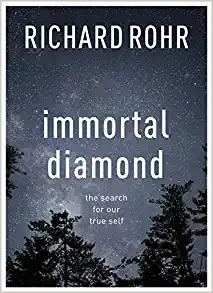This Tuesday we will begin our Eastertide study of Richard Rohr’s book The Immortal Diamond: The Search for Our True Self. We will be discussing the Invitation, Preface, and Chapter 1 “What is the True Self.” As you read the book in preparation for our discussion, please have your Bible nearby. Rohr cites the Scriptures generously, and it will be helpful to have those citations at your fingertips. **Rohr writes that this Book is for “secular seekers and thinkers, believers and nonbelievers alike.” (p.xvii)** If you know someone that fits this description, please invite them.
When we look at Rohr’s Invitation, his book stands in opposition to Ecclesiastes. Ecclesiastes is the book of Good Friday. All is havel havelim because of the evils under the sun and the inevitability of death which comes for one and all. Rohr speaks to us on Easter morning, in the light of the Resurrection of Christ in which death and evil and victimhood are left behind and a new, transformed, and resurrected creation has arisen.
Rohr’s Invitation to us is to enter into this Resurrection. “Resurrection” means transformation and change into the image of God. When we look at the Easter accounts in the Gospels, Jesus has been transformed. He looks different so neither Mary Magdalene (John 20:15) nor Cleopas (Luke 24:16) recognized him. As Paul so eloquently writes, the Resurrection means that whatever is sown perishable is raised imperishable, sown in dishonor is raised in glory, sown in weakness is raised in power, and sown physically is raised spiritually. 1 Cor. 15:42-44. And so it is to be with us who are in Christ. Our old false self has been (or needs to be) crucified so that a new true self can be resurrected. Rom. 6:6, Gal. 2:20.
One of the recurring themes in “The Immortal Diamond” that Rohr introduces in the Preface is that resurrection and the finding of the true self begin with a change of our identity. For Rohr, this change (i.e. “conversion”) is the very heart of all religious transformations. (p.xxiv). This change of identity is best seen in the person of Paul. Paul’s identity was that of a religious, Scripture-abiding, God-fearing Jew: “circumcised on the eighth day, of the people of Israel, of the tribe of Benjamin, a Hebrew born of Hebrews; as to the law a Pharisee, as to zeal a persecutor of the church, as to righteousness under the law blameless” (Phil. 3:5-6). However, it is this old identity that dies and a new identity that is born on the road to Damascus. Acts 9. For to live is Christ, and to die (to his old identity) is gain. Phil. 1:27. We are to have this new identity (this true self) “in Christ.” Rom. 6:11, 8:39.
One of the other themes Rohr introduces in the Invitation and Preface is that Christ is the archetype “True Self” (p.xiii). Again, we see this same understanding in Paul’s writings when he compares the archetypes of Jesus and Adam in Romans 5:12-21 and 1 Corinthians 15. For as in Adam all die, so also in Christ shall all be made alive. 1 Cor. 15:22. Or as John writes: Jesus “is the Way, the Truth, and the Life.” John 14:6. Jesus is the manifestation or archetype of the True Self.
Dinner is at 6. The menu is a cobb salad bar. Discussion begins about 6:45. Hope to see here. Please bring a friend.
My only job, and yours too, is to imitate God in the same love of life. And if God has given such grace and given life so abundantly and so broadly (Acts 11:22) then who am I to stand in God’s way (Acts 11:17)?
Immortal Diamond, p.xxv

